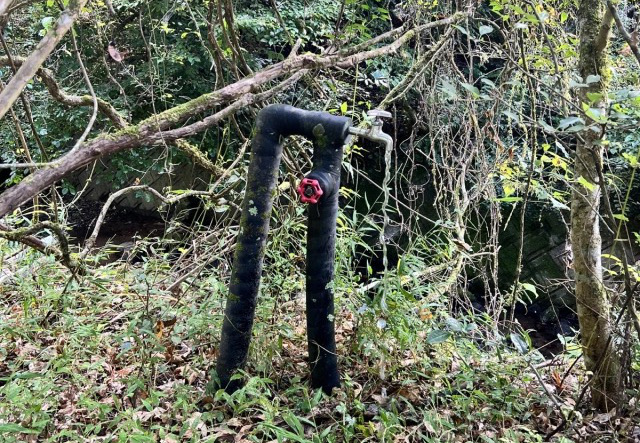
Dare we drink the water from this strange source we discovered on our property?
Last year, we bought a house in the Japanese countryside for US$9,100, and since then we’ve been making all sorts of unusual discoveries involving mountaintop views and visits from local raccoons.
Our latest discovery was a mysterious tap, which we found after clearing out some overgrown bushes next to the house.
“Tap posts”, as standalone outdoor taps are officially known, usually consist of a tap attached to a vertical wooden plank, not a weird pipe-looking protrusion like this one. Our reporter Go Hatori had never seen anything like it before, and being the curious countryside explorer he is, he wasted no time in turning the faucet on, but what came out was brown, muddy looking water.
▼ The SoraHouse is yet to be connected to a water supply, so none of the other taps on the property work.
Finding a source of running water on the property that might be fit for consumption was an exciting prospect for our ever-thirsty renovation team, but first they needed to solve the mystery of where the water was coming from.
It was clear to everyone that the tap wasn’t connected to the nearby river, so everyone’s next best guess was that it might be coming from some sort of well. Our boss, Yoshio, however, was able to speak to the former owner of the property, who told him that what they’d found wasn’t well water, but mountain spring water.
Apparently, this water is free to use, and the other houses nearby also have similar taps giving them access to the water source. The SoraHouse is located halfway up a mountain, and according to the previous owner, a factory at the bottom of the mountain sterilises the very same water and sells it as natural mineral water.
This was an unexpected perk we hadn’t been told about when we bought the property, and seeing as it was spring water, we figured it must’ve come out brown at first due to the pipes being dirty and unused for so long.
▼ So we let the water flow for a while until it came out clean, and decided to test its safety with a water-testing kit.
We purchased the test kit from Amazon Japan, and though it was designed to test well water, it would still do the trick with our outdoor tap, as it would measure pH, iron, total hardness, chemical oxygen demand (COD), and nitrous acid levels.
As a result of measuring the levels according to the instruction manual, we discovered that all these levels fell in the “no problem” range, which was all the reassurance the team needed to surmise that the water should be safe to drink!
All that was left to do now was drink the water, so with their hearts pounding, Go first took a sip. His evaluation?
▼ “Delicious!”
What about Yoshio?
▼ “Yes, this is water!”
And our trusty professional from local construction company Hobien?
▼ “No problem!”
Our three musketeers are happy to report that none of them had any digestive issues after drinking the water, but after reading the PDF manual for the well water test, they realised they’d skipped past this rather important piece of information:
“It is not possible to judge whether the water tested is drinkable or not based on these five items [pH, iron, total hardness, COD, and nitrous acid] alone. This is because it is not possible to determine whether the water is contaminated with metal ions or other chemical substances from chemical plants, construction sites, mines, or the natural world, or whether bacteria such as E. coli are present.
If we were to conduct an inspection for every possible situation, we would have to measure more than 50 items, and moreover, experts would have to make full use of expensive analysis equipment. ”
After doing some more research online, Go discovered that in Saitama Prefecture, where the SoraHouse is located, the public health centre tests 13 items, and the health research institute tests 51 items when conducting water surveys. The fee for public health centre testing is a very reasonable 9,740 yen (US$66.33), so an official test is now on the ever-growing to-do list for next time we’re at the SoraHouse.
Until then, Masanuki will be using the newfound running water for outdoor baths in his giant shoe.
Photos ©SoraNews24
● Want to hear about SoraNews24’s latest articles as soon as they’re published? Follow us on Facebook and Twitter!
[ Read in Japanese ]